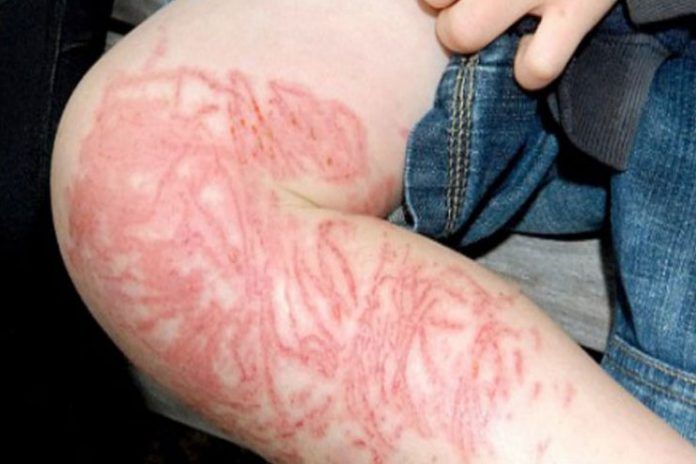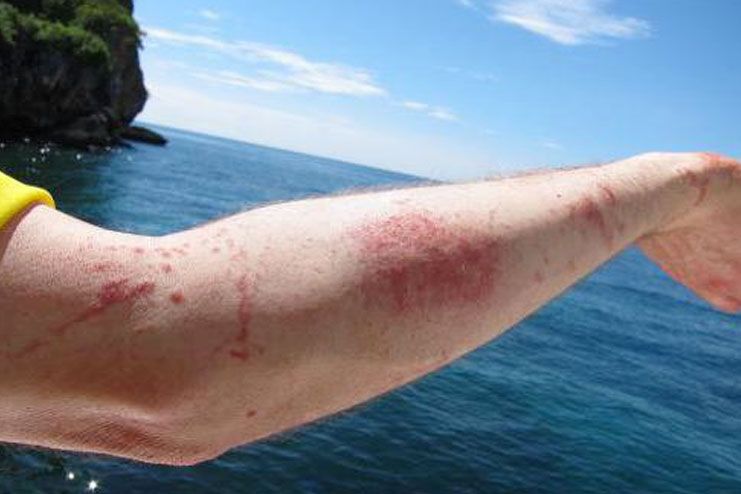Affiliate Disclaimer
Some links in this article are affiliate links. We may earn a small commission if you make a purchase through these links, at no extra cost to you. We only recommend products we find useful to our readersInjuries are quite common among people who wade, dive, or swim in seawaters. One such possible injury is Jellyfish stings, caused due to jellyfishes. It may not be a serious medical condition many times, but may turn troublesome in a few cases and that is when proper treatment for jellyfish stings is required. Also, several home remedies can help with Jellyfish sting relief. Read through this HeathSpectra post to learn everything about Jellyfish stings.
What Are Jellyfish stings And Its Causes?
Jellyfish are non-aggressive, free-swimming, gelatinous marine animals surrounded by tentacles covered with the sacs called nematocysts. These sacs are filled with poison (venom). When people swimming in seawater encounters these tentacles, the condition called jellyfish stings develop. The condition can be painful and sometimes cause life-threatening stings as the jellyfish long tentacles can inject the person with venom from the microscopic barbed stingers.
Types Of Jellyfish:
The severity of Jellyfish stings may be more-serious problems in people encountered by these jellyfish:
- Box jellyfish (warm waters of the Pacific and Indian oceans) can cause intense pain and life-threatening reactions more common with this type.
- Portuguese man-of-war or bluebottle jellyfish (located in warmer seas) has a blue or purplish gas-filled bubble that acts as a sail. It keeps the fish afloat on the water.
- Sea nettle (common in both warm and cool sea waters) are abundantly found along the northeast coast of the US and the Chesapeake Bay.
- Lion’s mane jellyfish (the world’s largest jellyfish) are common in cooler, northern regions of the Pacific and Atlantic oceans. The body diameter of these fishes are over 3 feet (1 meter).
How Do Jellyfish stings Look Like?
The blisters or shallow sores/ulcers formed by the jellyfish and site of stings may look bluish purple and dusky. These may get healed in weeks. Chances for the permanent scars may even be high at the affected site.
Often jellyfish stings result in immediate pain, irritated, red marks on the skin. Sometimes, whole-body (systemic) illness may also develop. In rare cases, jellyfish stings turn life-threatening. However, home treatment is enough to get most jellyfish stings better. But, severe reactions require emergency medical care.
Thus, the severity varies greatly. The main factors that lead to varied severity include:
- The potency of the venom and the type of the jellyfish.
- Depends on the season as the venom gets more stronger during some seasons.
- One’s age, general health, and size.
- Based on the extent of stung body surface.
- The number, size and location of the body where the jellyfish are stung.
What Are The Symptoms Of Jellyfish Stings?
The symptoms Of Jellyfish Stings varies. They may be severe or mild, and immediate or delayed. In most cases, the healing is usually slow. The pain from Portuguese man-of-war stings or jellyfish may be intense and may last for hours. The stings of jellyfish or sea anemone larvae develops rashes called Seabather’s eruption.
More symptoms can include:
- Shock and pain
- Swelling in the throat, mouth, lips, tongue, mouth, ears, neck, feet, eyelids, palms.
- In case the swelling interferes with airways, it may be more dangerous.
- difficulty breathing
- Wheezing
- Cauging
- Confusion
- Lightheadedness
- Vertigo
- Vomiting
- Diarrhea
- Stomach cramps
- Chills
- Hives
- Muscle cramps or spasm
At times, days or weeks after the sting, skin rashes may develop, which are called delayed symptoms. Delayed symptoms may show up even after a couple of months following a sting. Thes symptoms accompany other symptoms like
- Fever
- Joint stiffness
- Weakness
- Swelling
- Itching
In such cases, the complications could subside by the medical treatment.
Procedure For First Aid or Home Treatment For Jellyfish Stings:
Home treatment is usually enough to eradicate skin irritation and rash caused due to minor jellyfish or Portuguese man-of-war stings. Below is the common home procedure followed to treat Jellyfish Stings.
Step 1: Remove the person from the water and wash the affected area vinegar. The American Heart Association recommends to rinse the area with vinegar or baking soda for 30 seconds. These help deactivate stinging cells.
Step 2: Pluck visible tentacles with fine tweezers.
Step 3: Immerse the leg or arm for around 20 minutes in the hot water (40 to 45 degree centigrade), else let the person take a hot water shower. Incase the affected area can’t be soaked on hot water, cold packs can be used as alternatives.
Step 4: Apply hydrocortisone cream or oral administration of antihistamine to get relief from the jellyfish itch and swelling. Follow-ups are essential.
Note: Avoid unhelpful or unproved actions as first aid, like: scraping out stingers, rinsing with human urine or freshwater, applying meat tenderizer, alcohol, ethanol or ammonia or pressure bandages
How To Treat Jellyfish Stings?
Even though rashes like Seabather’s eruption are uncomfortable, they not dangerous and neither are a serious medical condition.
- Sores that are formed due to jellyfish stings may heal without treatment.
- For less severe cases, over-the-counter pain relievers or ice-packs can be used.
- Open sores have to be cleansed thrice a day and antibiotics are to be applied.
- Wounds formed due to jellyfish stings are to be cleansed at least thrice a day using antiseptic ointments.
- In severe cases, the affected person may be hospitalized and anti-venom may be administered for box jellyfish stings.
- Deep sores required medical treatment to prevent any further infection.
- A jellyfish sting near an eye needs immediate medical care for pain control along with eye flushing.
- In case of severe allergic reaction (anaphylaxis) of the body system, an emergency care is required.
Note: If children put a part of the jellyfish tentacle in their mouth they have high chances of stings in the mouth or throat that causes sudden severe swelling and may turn life-threatening.
How To Prevent Jellyfish Stings?
A way to prevent Jellyfish Stings is to avoid activities in the sea waters with a number of jellyfishes. Other ways which can possibly help prevent jellyfish stings include:
- Wearing a protective suit: A wetsuit or other protective clothing can help while swimming or diving in areas with high possibility of jellyfish stings. Stinger suits made of high-tech fabric as well as the protective footwear work well while wading in shallow water.
- Gathering a lot of information: Collect as much information as possible from the local residents, lifeguards or the health department officials before attempting to swim in the coastal waters where jellyfish are common. And prefer to stay away from the water when the jellyfish count is high in a few seasons.
In short, playing in the seawater may be fun but Jellyfishes may turn out to be spoil sport. To avoid Jellyfish stings, be extremely careful while attempting any fun activity in the sea water, specially where jellyfishes are high in number. Incase of discomfort or suspected injury, seek immediate medical attention and get right Jellyfish sting treatment.





























